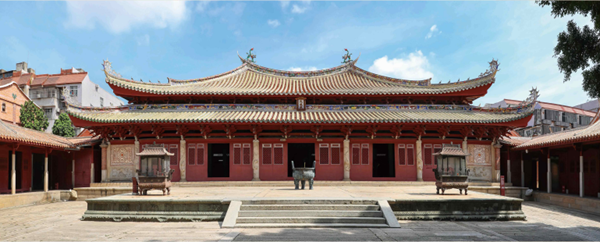- About
- UNESCO Heritage


威尼斯人马可波罗看到过极盛的元代泉州,她“所卸胡椒甚多,若以亚历山大运赴西方诸国者衡之,则彼数实微乎其微,盖其不及此港百分之一也。此城为世界最大良港之一,商人、商货聚积之多,几难信有其事。”
The Venetian Marco Polo saw Quanzhou in its heyday during the Yuan Dynasty. He wrote: "The quantity of pepper imported there is so considerable, that what is carried to Alexandria, to supply the demand of the western parts of the world, is trifling in comparison, perhaps not more than the hundredth part. It is indeed impossible to convey an idea of the number of merchants and the accumulation of goods in this place, which is held to be one of the largest ports in the world."
《半城烟火半城仙》泉州城市宣传片(宋元中国·海丝泉州)
泉州,坐落于中国东南沿海,是10-14世纪繁荣海洋贸易网络东端的商贸中心,宋元中国杰出的对外经济与文化交流窗口,世界海洋商贸引擎型港口的杰出典范。彼时的泉州不仅有着完备的制度体系,极其繁荣的海外贸易,高度发达的经济水平,更是东西方文化交融荟萃之地。今日的泉州城内依然回响着这样的历史韵律,人们生活在历史遗产间,历史的、现代的,泉州的、世界的在此交相辉映。
Quanzhou, located on the southeast coast of China, was a bustling commercial center on the eastern end of the maritime trade network that flourished from the 10th to 14th centuries. During the Song and Yuan Dynasties, Quanzhou served as a prominent window for China's economic and cultural exchanges with the outside world, and it was also an outstanding example of a world-class port that served as an engine for maritime commerce. During that era, Quanzhou not only had comprehensive institutions and systems, incredibly prosperous overseas trade and a highly developed economy, it was also a place where Eastern and Western cultures converged and flourished. Today, the city of Quanzhou still echoes with this historical cadence. People live amongst the historical heritage, and it is here that the historical and the modern, the local and the global intersect each other.
第一部分
宋元时期的外国人来到泉州可以看到,“港内停有大艟克约百艘,小船多得无数。这个港口是一个伸入陆地的巨大港湾,以至与大江会合。”她仿佛是整个世界的一座城市。千年古港泉州历经多少代人的风帆贸易和财富积累才造就了这些屹立于大地上的世界遗产。姑嫂塔、六胜塔是迎接海船来往的航标塔,三湾十二港为多少中外友人提供过憩泊,江口码头、洛阳桥、安平桥等交通设施输送着来来往往的珍贵货物。
During the Song and Yuan Dynasties, foreigners who came to Quanzhou could see "about a hundred big junks there and innumerable little ones, and a great gulf of the sea running inland till it mingles with the great river." Quanzhou was seemingly a city for the entire world. Numerous generations of merchant sailors plying their trade and building up wealth here eventually led to the towering World Heritage sites that make up the millennium-old port of Quanzhou. The Wanshou Pagoda and Liusheng Pagoda served as navigation markers for ships entering and leaving the port. The three bays and twelve sets of docks provided Chinese and foreign sailors with ample places to anchor. The Estuary Docks, Luoyang Bridge and Anping Bridge greatly facilitated the flow of precious goods.

洛阳桥
中国现存最早的跨海梁式大石桥
Luoyang Bridge
China's earliest surviving sea-crossing stone bridge

安平桥
中国现存最长的跨海梁式石桥
Anping Bridge
China's longest surviving sea-crossing stone bridge

六胜塔
泉州湾的重要航标塔
Liusheng Pagoda
A major navigation marker in Quanzhou Bay

妈祖巡香
The Mazu Incense Parade
第二部分
走在泉州古城,几步便能遇见一座庙宇。她既有烟火气,又充满仙气,是一座众神之城。10-14世纪,数以万计来自亚非欧的商人与传教士聚居在这里,与此地的政府官员、皇族、精英和平民共同构成宋元泉州的多元社会群体。他们使泉州成为极富世界性的商业社会,留下独特灿烂又多元的古城底蕴。
When strolling around Quanzhou's old town, you will inevitably come across a temple in just a few strides. A city of deities, Quanzhou possesses a spiritual charm amidst the hustle and bustle of city life. Between the 10th and 14th centuries, tens of thousands of merchants and missionaries from Asia, Africa and Europe settled down here, creating a diverse society in Song-Yuan Quanzhou together with government officials, royal family members, elites and commoners. They transformed Quanzhou into a highly cosmopolitan commercial society which left behind unique and diverse heritage.

泉州古城
Quanzhou's old town

清净寺
中国现存最早的伊斯兰教寺
Qingjing Mosque
China's earliest surviving mosque

泉州文庙
中国东南地区最大的孔庙建筑群,儒家祭祀场所和泉州最高等级的教育机构
Quanzhou Confucius Temple and School
The largest Confucian temple complex in Southeast China, a place of Confucian worship, and the highest-level educational institution in ancient Quanzhou
第三部分
背山面海的地理条件,向海而生、开拓进取的海贸传统,敬畏自然与神明的民俗特点,塑造了泉州多元、开放、包容的城市特质。各种不同的艺术与生活形态在泉州千年传承,这里“见人、见物、见生活”,是一座令人流连忘返的活态古城。
The geographical location between the mountains and seas, the pioneering and enterprising maritime traditions, and the cultural customs of reverence for nature and deities have shaped Quanzhou into a diverse, open and inclusive city. For centuries, various forms of art and lifestyles have been passed down in Quanzhou. Here, you can "see people, see things, and see life". It is a living ancient city that captivates peoples' imaginations.

南音
2009被联合国教科文组织列入《人类非物质文化遗产代表作名录》
Nanyin (a style of traditional Chinese music that originated from Quanzhou)
Inscribed in 2009 on the UNESCO Representative List of the Intangible Cultural Heritage of Humanity
《泉州世遗宣传片》长片英文版
